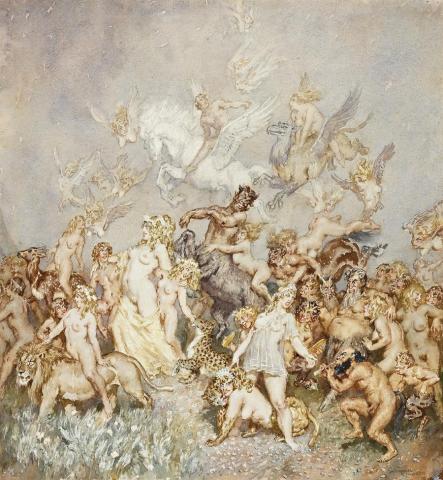THE ENTOURAGE, c.1940
NORMAN LINDSAY
watercolour on paper
54.5 x 50.5 cm
signed lower right: NORMAN / LINDSAY
Private collection, Sydney
From Pan to Pegasus amid a rollicking host, Norman Lindsay creates a cavalcade of joy in The Entourage. It is as if a marble frieze from an ancient Greek temple had burst into life with all the bawdy gusto that Lindsay could endow his work. The title suggests a group of people in attendance on someone important and sets the mind on discovering who that might be. A fair blonde accompanied by a youth and maiden might suggest Aphrodite (Roman Venus), yet the numerous leopards are attributes of Dionysus (alias Bacchus). The sky is filled with Sirens, who seduce men through the beauty of their singing. Below, a portly and unsteady Pan needs support. In Greek mythology, Pan was represented as a satyr, god of the wilds, with the horns and lower half of a goat. A somewhat lecherous creature of fertility, his homeland was Arcadia, that rustic paradise, or ideal place about which Lindsay philosophises. Or might the centaur play a dual role, that also of Silenus, the elderly associate of Dionysus, usually inebriated, as seen here?
The clue to the picture must lie in the compositional apex, that central focal point which fixes on the centaur, rearing and revealing with pleasure. Creature, half horse and half human, he is caught between the natures of the two. Ridden bare back by a lusty lady, the centaur embodies untamed nature, part man, part beast - and sexual freedom. To emphasize his credo, Lindsay claims that same freedom for the skies. Here the dominant figures are the white winged horse Pegasus ridden by its hero, and the gryphon. With the head of an eagle and body of a lion, the gryphon represents intelligence and strength. The man-beast interchange and allied freedom is taken up by the siren to the left, kissing a woman riding a deer of gentler nature. Back on earth, and pointedly in the centre foreground, a triple figure, parts leopard, lady, and man, stares challengingly out of the picture. Through the clashing of cymbals and playing of pipes, Lindsay presents The Entourage in the guise of a bacchic procession in honour of Dionysus/Bacchus, son of Zeus and Semele, god of wine, associated with goats through sacrifice and as an attribute. The absence of the god himself allows concentration on his followers, who find unlicensed freedom in their devotions to their god.
Writing in an introduction to a book on the philosophy of Lindsay, the celebrated Australian poet A.D. Hope referred to Lindsay as one who 'would heartily have echoed [William] Blake's celebration of the morality of gratified desire and the beauty of the natural world untrammelled by social prudery.' Quoting Blake, the final line was, 'The nakedness of woman is the work of God.'1
1. Hope, A. D., 'Introduction', Siren and Satyr: the personal philosophy of Norman Lindsay, Sun Books Pty Ltd, Melbourne, 1976, p. 8
The pride of the peacock is the glory of God
The lust of the goat is the bounty of God
The wrath of the lion is the wisdom of God
The nakedness of woman is the work of God
From Proverbs of Hell by William Blake
DAVID THOMAS
